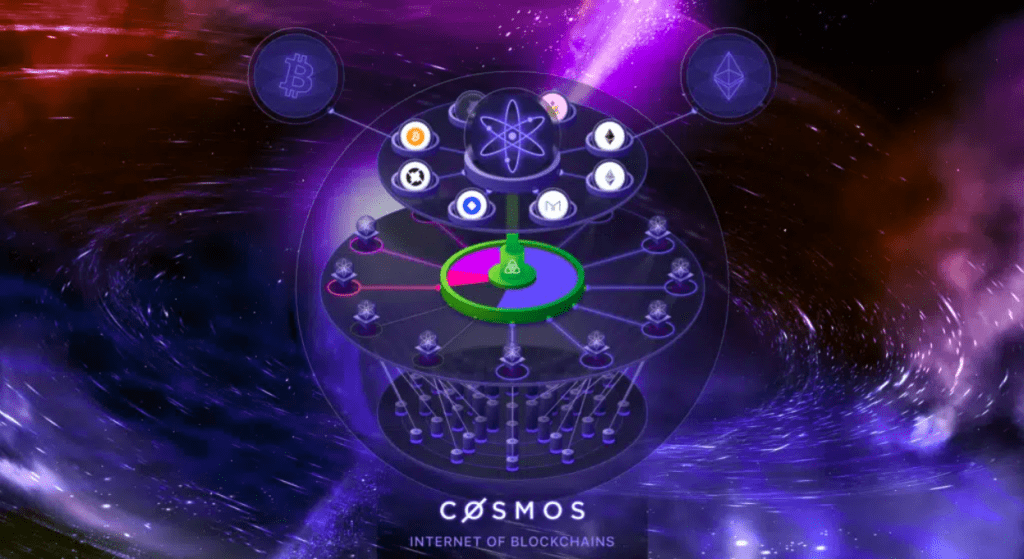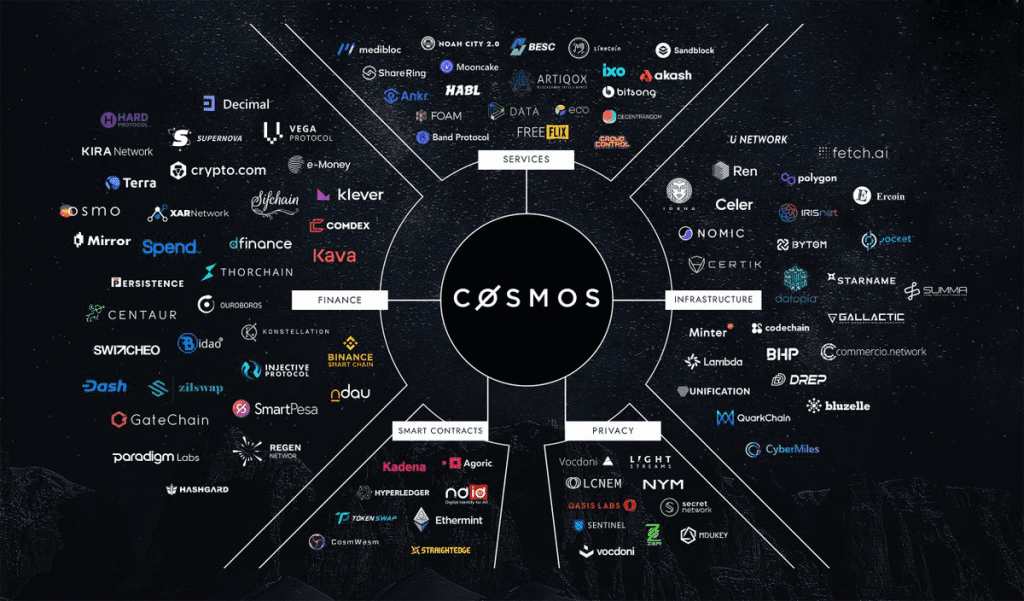Cosmos is one of the first “Internet of blockchain” projects on the crypto market. This article will tell us what Cosmos is. The technologies behind it and its ecosystem are

What is Cosmos?
Cosmos Network is a Blockchain platform with a Tendermint consensus mechanism. Different from the usual way of thinking like Solana, Terra, and Binance, … often the Blockchain platform will have Dapps built on top, it can be seen as “Layer 0” and on top of it will be many layers first.
Cosmos’ vision is to be the “Internet of Blockchains” creating a world where layers 1 are interconnected through a cross-chain protocol called IBC (Internet Blockchain Communication).
Core products
In this section, I present the main products that Cosmos has been building.
Cosmos’ goal is to help solve transaction fees and congestion on the Ethereum network and become a blockchain that connects all other blockchains. Core products that help it realize its vision of becoming the “Internet of Blockchain” include Cosmos SDK, Terdermint BFT, and IBC communication protocol.

Cosmos SDK
Cosmos SDK is a set of Module Framework, allowing projects to easily deploy their blockchain by assembling modules for their own purposes so that they can interact with each other.

Features of Cosmos SDK:
- Modularity: This allows you to use Cosmos SDK to design your own Blockchain according to specific needs.
- Scalability: Allows blockchains to run in parallel.
- Interoperability: Blockchains can exchange tokens and data easily through IBC.
- Security: The PoS mechanism ensures the security of Dapps on the blockchain.
- Governance: Voting and Proposal mechanisms are implemented through the Governance Module.
Tendermint BFT
Tendermint BFT is a solution that provides both the networking and consensus layers of a blockchain needed to build, into a common set of tools. Tendermint is connected to the Application Layer by a protocol called the Application Blockchain Interface (ABCI), which supports a variety of programming languages. Allows developers to focus on application development instead of wasting time with complex protocols.

Features of Tendermint BFT:
- Allows for Public or Private blockchain design: Tendermint BFT only handles networking and consensus for a blockchain, which means it helps nodes transmit transactions and validators to add to the blockchain. So developers can optionally build and customize the rules that determine the Validator of the blockchain, from which the blockchain design is public or private on the Tendermint BFT engine.
- High performance: Can handle more than 1,000 transactions per second.
- Instant Finality: A property of the Tendermint consensus algorithm is instant finality. This means that if more than one-third of Validators refuse to fork a Layer 1, the network will not allow that Layer 1 to exist.
Users can be sure that their transactions are completed as soon as a block is generated. - Security: Tendermint is not only fault-tolerant, but also responsible for mechanisms like Staking, Governance, and Slashing.
IBC
IBC (Internet Blockchain Communication) is a cross-chain communication protocol that helps Cosmos connect all Layer 1 Blockchains built on it SDK together, and can easily transfer tokens and arbitrary data together.

IBC is considered a bridge. Users can send tokens to the IBC endpoint, origin chain will freeze the sent token while receiving chain will receive a corresponding wrapped token. If you want to get the original token back, just send the wrapped token back to the original chain.
The only difference between IBC and bridge is that it automatically connects all Blockchains, as long as those chains have integrated IBC and the permissionless nature it provides. There is no need to build a separate bridge when you want to connect to another chain.
Cosmos Ecosystem

Regarding the ecosystem, there are many projects that build and interact with Cosmos. I will make it clear as follows:
Cosmos is a blockchain that follows the Internet of blockchain model, so the ecosystem is very large. More than 263 dapps under construction and development with total assets up to $167B. There are about 80 projects built using the Cosmos SDK and operating in the ecosystem as a separate Blockchain. In the framework of this article, I only refer to projects that are built with the Cosmos SDK and act as a blockchain of it.
Some prominent Blockchain dapps include:
- Osmosis: The first AMM protocol in the ecosystem. Osmosis is seen as the liquidity hub on Cosmos. With the number of transactions transferred through IBC is up to 200K transactions per day.
- Iris Network: A centralized Cross-chain service for Dapps, Iris Hub enables Cross-chain collaboration and provides Modules to support DeFi.
There are currently 49 mainnet projects connected to IBC. On average, there are about 3 connected projects every month with a growth rate of 22%. At this rate, by the end of 2022, the number of projects will reach 64 projects and reach 100 projects by the end of 2023. Cosmos’ deployment speed is much faster than competitors at the moment.

Verdict
Above is all information about Cosmos as well as its ecosystem. Cosmos took 5 years to realize its “Internet of Blockchain” vision. In the following article, I will analyze more clearly the technological aspect and its technological strengths and weaknesses of it compared to other competitors such as Avalanche, Polkadot,…
If you have any questions, comments, suggestions, or ideas about the project, please email ventures@coincu.com.
DISCLAIMER: The Information on this website is provided as general market commentary and does not constitute investment advice. We encourage you to do your own research before investing.
Ken. N
Coincu Ventures














